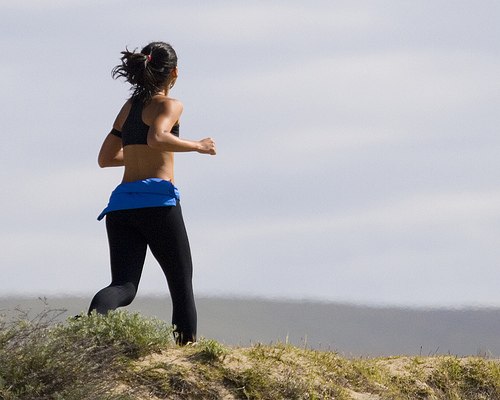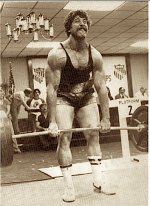"Top 5 List of Aerobic Activities - How Do You Score?"
How do you score?
Your top 5 list of aerobic activities reveals if your favorite aerobic activity is the right fit for you.

Photo courtesy of Mike Baird
The Fifth Element
Exercise performance is simple to understand once you break it down into its 5 major elements. In a moment we'll determine what these key elements are, then focus on how they effect you. Finally, we shall examine the top 5 aerobic activities to see how they train and condition the body, and go about the business of building muscle.
While you are reading, you might want to grab yourself a pen or pencil and see how you score.
Do some exercises fit you better than others?
Better be ready for a few shocks and surprises!
List of Aerobic Activities Explained
Basically, there are 5 major elements of exercise performance. Knowing these elements will guide you towards a better understanding of aerobic activity and those exercises that naturally fit your requirements.
As any conditioning goals will vary depending on the individual, it is important you select an activity that meets your targets. For example, a keen tennis enthusiast who wants to improve their game will find steady jogging little help to their quickness across the tennis court. To train for tennis excellence, you must train for speed.
And what about the beginner wanting to get in shape?
Steady jogging at a slow to moderate pace now becomes a perfect fit for the novice trainee.
The 5 major elements of exercise performance are:
- Muscle mass
- Muscle endurance
- Cardiorespiratory endurance
- Mobility
- Durability
Now let's take a look at this famous five in greater detail:
|
1. Muscle mass is determined by the size of fibers in your muscle tissues. Strength training typically develops muscle mass which is a prelude to developing muscle endurance and strength. (Muscle strength is the brute force you can apply in an all-out rapid single muscle contraction.)
2. Muscle endurance enables you to contract your muscles many times before encountering fatigue. 3. Cardiorespiratory endurance is the ability of your heart and lungs to keep you moving for a long time. 4. Mobility is your body's flexibility to reach, turn and bend. 5. Durability enables your joints, ligaments and musculature to withstand sudden jolts and repeated knocks. |
Important: These elements have varying importance depending on the aerobic activity or sport.
Using tennis as our list of aerobic activities example, this activity requires a moderate amount of muscle mass and a high level of muscle endurance (lots of running and jumping).
Cardiorespiratory endurance is also important due to any prolonged rallies, as is mobility to allow for quick changes in direction. Durability also scores high.
Now let's finally see how the top 5 aerobic activities train and condition the body, and go about the business of building muscle.
Top 5 List of Aerobic Activities
1. Cycling.
Muscle endurance and cardiorespiratory endurance take precedence over muscle strength when cycling. First train with long slow distance, and as you become better conditioned, employ interval training. Gradually elevate your heart rate to at least 80% of maximum, with periods of all-out effort if you are racing.
Want to discover what interval training can do for you? See Tabata Training
2. Jogging and Distance Running.
Muscular strength is not a prime requirement here - muscle endurance is. To this end, you'll want to lose any excess fat if you are a serious trainee. Beginners should work their way up to a training pulse rate of 70% of your age-adjusted maximum, proceeding to 70-80% as fitness and conditioning improves. You can gauge any improvements by the ease with which you can run distances that were difficult for you at the outset.
Are you a tortoise or a hare? For your 3-step sprinting form guide, see Sprinting Technique
3. Rowing.
Training for rowing scores high in most areas of exercise performance, making it an effective all-rounder when looking to build muscle mass, endurance, and cardiorespiratory endurance. Rowing at a moderate to fast pace puts a training stress on the circulatory system, which helps condition the overall body. Further conditioning can be accomplished through interval training after an initial several weeks of long, slow distance training.
4. Swimming.
Like rowing, swimming scores high in most exercise performance areas, making it an excellent choice of aerobic activity for both the experienced and beginner trainee. Unlike rowing, swimming does not require a high amount of muscular strength. Instead, muscular endurance is required, and mainly in the upper body as most of the propulsion in swimming is derived from the arms.
Want to see how your heartbeat holds the key to your fitness? Go to Best Aerobic Activities
5. Tennis.
Tennis also scores highly in most exercise performance elements. However, to play well some overall conditioning is important to guard against injuries. (Tennis, with its violent and sudden movements, puts great strain on the legs, arms and joints.) If your beginning fitness is low, tennis sessions should be short, not exceeding half an hour. As overall fitness improves, the play duration can gradually be increased.
In Summary
How did you score? The above list of aerobic activities targets all major 5 elements of exercise performance. The benefits: you get to enjoy aerobic activities that are effectively tailored to your individual requirements.

Comments
Do you have a comment or question you want answering? Share it here!
What Other Visitors Have Said
Click below to see contributions from other visitors to this page...
Running vs Swimming to Burn Calories? 




Is running or swimming best to burn calories and get in shape? I enjoy swimming, as I don't get so tired and feel there is less stress on the joints.
…
The Best Interval Training Techniques? 



What different Interval Training techniques are people doing? i.e. rowing, sprinting, bike? Anyone have any suggestions?
Recent Articles
-
Minimalist Training - How Little Can You Do to Get Insanely Strong?
Jun 29, 20 11:35 AM
Hear how minimalist training helped 80s powerlifter Mark Chaillet crush his competition and get insanely strong. -
Deadpool Superhero Workout - Two Critical Exercises to Develop X-Men Strength
Apr 23, 18 05:22 AM
Discover how the Deadpool superhero workout develops freaky fitness and X-Men strength. -
Why Weight Training Too Hard is Hurting Your Gains
Sep 25, 17 10:50 AM
Feeling fatigued? Discover why weight training too hard at the gym is hurting your gains.




